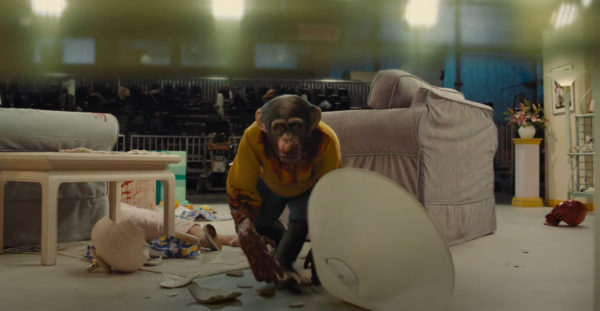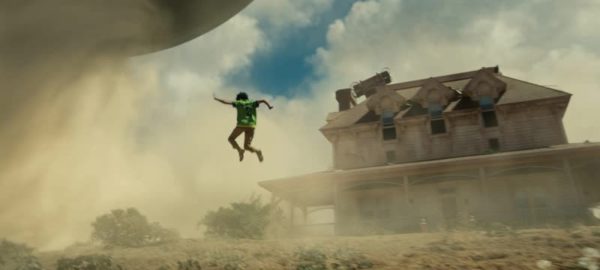
Jordan Peele‘s third feature is an ode to spectacle, the fleeting fame of Hollywood and the POC who are churned up and forgotten by the system like Jean Jacket’s victims.
THE FILM
Nope is a fascinating film. Like all of Peele’s work, it feels deeply personal, yet extremely accessible to a broad, mainstream audience. It’s a horror film, a Western, a sibling drama, and a comedy about enterprising entrepreneurs caught up in something much larger and more alien than they bargained for.
At its heart, Nope is about Emerald (Keke Palmer) and OJ Hayward (Daniel Kaluuya), adult siblings who inherit their father (Keith David)’s Hollywood horse ranch after he is killed in a freak accident. The details of his death are wrapped up in a strange series of localized events involving a mysterious cloud that is strangely immobile in the sky.
When Emerald and OJ realize that the only way to save their family’s legacy from foreclosure is to capture an image of the strange new creature, they (somewhat inadvertently) enlist the help of local tech salesman Angel (Daniel Perea), as well as renowned filmmaker Antlers Hoist (Michael Wincott).
Also caught up in the drama is former child star-turned-theme-park owner Ricky ‘Jupe’ Park (Steven Yuen) who has been buying up OJ’s supply of horses for his new show. As the danger mounts, the question alternates between who will survive their encounter with the creature and who will score the proof of its existence that will solidify their Hollywood legacy and assure their financial future?

REVIEW
I caught Nope earlier this summer in its theatrical release (listen to the Horror Queers episode here) and, like all of Peele’s films, a single viewing is hardly sufficient to unpack what the filmmaker is doing. The greatest struggle on a first watch is realizing that – barring the confronting (and horrific) opening sequence on the set of Gordy’s Show – the film is more of a Western-meets-UFO film than the straightforward horror film that many expected.
Shot in 65 mm on IMAX cameras, the scope of the film is massive, and several sequences, such as the massacre at Jupiter’s Claim and the resulting blood rain when Jean Jacket unleashes hell on the Hayward home, are truly exceptional.
One wishes Yuen had more screen time, but Palmer’s energetic performance as Emerald is a great compliment to Kaluuya’s quiet, reserved OJ. Perea is the break-out star: he’s funny, cute and a great foil to the siblings’ drama. Wincott doesn’t arrive until late in the film and while the character actor imbues Hoist with an enigmatic quality, his arrival unfortunately coincides with larger narrative developments and Antlers feels underdeveloped as a result.
The ambitious project clocks in at over two hours and occasionally drags in the middle, but I would happily watch a longer cut considering Nope‘s weighty thematic interests. It doesn’t hurt that the film is gorgeously shot and designed. It may not be my favourite Peele film, but his work is so immaculate that each new film immediately becomes an “event”…or a spectacle, if you will.

EXTRAS
Knowing how deliberate and precise Peele is, I was most excited to check out the special features on the disc to get further insight into his process.
In addition to deleted scenes (insignificant) and a gag reel (predictably amusing), the stand-out featurette is “Shadows: The Making of Nope,” a 55 minute overview divided by chapters and composed of scenes of Peele directing, VO playing over film scenes and talking head interviews. It plays out in sequential order with the finished film, beginning with Gordy’s Home through to the final day of filming. Watching Peele direct Terry Notary as Gordy and Jacob Kim as young Jupe (and later the crowd scene of the massacre) is fascinating, as is the behind-the-scenes glimpses of Jean Jacket’s digestive tract and the work that went into the blood rain sequence (“All departments are turned up to 11” Peele jokes).
In addition to Peele, the features are dominated by producer Ian Cooper, production designer Ruth De Jong and cinematographer Hoyte Van Hoytema, all of whom pushed Peele to realize his vision more fully. The deep respect everyone has for the project, and particularly Peele, is extremely evident in these featurettes.
“The Mysterious Man of Muybridge” clocks in at a brief 5 minutes, but it succinctly explores why the clip of the black jockey is such a significant and lasting image.
At 14 minutes, “Call Him Jean Jacket” is a longer, more in-depth exploration of the work that went into creating Jean Jacket, whose origins are tied to the photography of Mapplethorpe and Robert Morris, as well as soft fabrics such as Marilyn Monroe’s dress from The Seven Year Itch and the enormous sails of antique ships. These details are fascinating, particularly the consultation work the production did with CalTech scientists and composer Michael Abels’ work creating the film’s ominous score. It is, however, a bit disappointing that there isn’t more time dedicated to visual effects supervisor Guillaume Rocheron‘s work on the creature’s various transformation in the last act of the film.
THE BOTTOM LINE
- Film: 3.5/5
- Extras: 4/5
Nope is now available on 4K, Blu, DVD and Digital